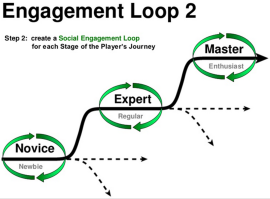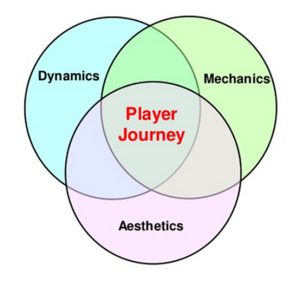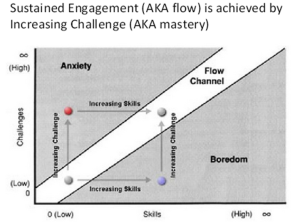The more I know Amy Jo Kim, the more I become an enthusiast of gamification as an experience development tool. She’s an expert in online collaboration and ceo of Shufflebrain, a consulting firm for game design, which she launched with Scott Kim. Her language is simple, her thought businesslike clear, and her ideas are in the center of the social online revolution and build on much of the marketing and product design reshaping that is happening today. Her (almost unnoticed in her presentation) PhD in behavioral neuroscience and BS in experimental psychology set the base for her perspective, from within the gamer/user/customer head.
She has this available book on community building and in this post I’m going to outline some of the key insights from a few of her online video presentations :
TEDx : Collaboration and Community Building on the Web (13min)
- Games are mainly assumed to be zero-sum results of people’s interactions. But this is not the whole possibility. Particularly in game theory non-zero sum games are generalized and the figure of partner and opponent can sometimes become confused.
- The world is changing fast and the rise of ubiquitous connected devices are provoking what Will Wright calls the Gambrian Explosion. Girls and adults are catching up boys and their needs of confrontation are not so exacerbated. The proof is in the proliferation of game-like mechanics such as in the addictive feel of Instagram (after facebook, etc..) or the collaborative entertainment of Draw Something, among others.
- The crux is in the individual search for happiness. It depends positively in building meaningful social connections and negatively in social comparison Collaboration is, highlights Jo Kim, a key XXIst century skill and through games we can (and we are) educate collaboration most pervasively and in mass.
Smart Gamification : Seven Core Concepts for Creating Compelling Experiences (30min)
- The first step in designing a gamified process is to know the players, particularly, what they need. This is a psychographic characterization that clusters users/players/customers in general behaviors and attitudes.
- Richard Bartle described an initial approach to this segmentation pointing out out that PBLs appeal mainly to the boys/competitive type. In his model engagement was driven by 2 juxtaposing dimensions : 1) focus on people (players) vs. focus on the imaginary (world), and 2) doing stuff (acting) vs. relating to stuff (interacting)
- Jo Kim picks on Bartle’s model and adjusts it to focus on social engagement. To characterize the key types of players she uses engagement verbs describing the main attitudes towards the gamified process :

- Examples of the different types are :
. the Competitive : Brainbudies
. the Collaborative ve : Cityville
. the Express : modcloth‘s system
. the Explore : Foursquare (particularly explore tab)
- The player Lifecycle or journey (slides 16-20) is a fundamental piece on the engagement level. Jo Kim points to 3 levels : the novice, who is on boarding > the regular, who is habit building > and the enthusiast who achieved mastery. Thus, learning (and applying what is learned) is the fundamental drug to keep engagement active and the correct question to answer is : what can your most enthusiast player do that others can’t?
- Gamified processes are characterized (and of interest to marketing) by engagement loops. They are way to feed the player’s enthusiasm back into the system.
- The key to create a sustainable engagement loop is to put PERMA into it. Fun isn’t one but of many positive emotions. Understanding what is the positive emotions that drive the player/user/customer in the jouney? E.g.: for Farmville is the visual pleasure and self-expression; for Foursquare is social serendipity; for Amazon is staying informed and building trust.
- The Game design perspective vs. Loyalty marketing (long articles) focus on 3 dimensions: mechanics, dynamics and aesthetics (MDA).
- Dynamics are patterns over time. What happens over time is known in behavioral psychology as the reinforcement schedule (also related are reward schedules). And if you have reinforcement patterns that have variability in them, these are much more addictive than very straight forward do-this-get-that in a deterministic sense, that’s what get you addiction, surprise and is very good at building habits.

- Mechanics aren’t detached from the game pace, they keep track and communicate to the player the choices and possibilities. The different elements (badges, quests, etc…) must be used in coordination with the dynamics to serve the goals of the designer.
- Aesthetics : it’s what engenders emotion. Your goal is to create emotion because it’s what drives action and engagement. E.g.: Facebook feed.
- The way to create sustained engagement (video 38min) is by delivering increasing challenge. If you’re not challenged enough you’re bored if you’re too challenged you’re anxious (this is important insight to educational systems, e.g. khan academy knowledge map)
- One of the key insights under this framework is to motivate players with intrinsic rewards. PBLs tell you if you’ve mastered things but they are not the drives to intrinsic motivation. From the Maslow’s pyramid principle (which orders different intrinsic motivators) we know that if we haven’t satisfied lower needs in the pyramid we can’t address the higher ones. So the question here is : where is my population’s unmet need? Is it belonging? Or are they good there and what they need is self-esteem?

- Today’s trend is to believe that intrinsic value trumps extrinsic rewards – so the key is figuring out what intrinsic value to go for. Extrinsic motivators are good for mechanical work, such as task completion, e.g.: Linkedin’s progress bar (#16), but that doesn’t quite reach sustained motivation. The key to it is communicating feedback and scheduling rewards as to support the intrinsically motivated activity. E.g.: Young driver insurance.

The slides of the presentation here.
Smart Gamification : Designing the Player Journey (41min)
- Gamification is using game techniques to make activities more engaging and fun. The focus is in the user experience. But game techniques is not the same as core experience, the game builds around the core experience.
- The player journey is the experience/progression over time, where you deliver to people special powers or privileges when they’re ready for it, when they’ve earned it. Good games give people something to master, a learning experience. E.g.: for Quora, mastery is knowing how to ask a good question, one that will get voted up and get popular. The needs of the player are different along the journey.
- The novice needs onboarding : a tutorial, a series of quests, you need to introduce the key features of your system during onboarding and give the user a sense of progress. The expert knows the ropes. He needs fresh content or fresh activities (when you log into facebook, you get fresh content all the time), alternatively powertools and customization if focus is not in the contents. Masters need exclusive access, activities and unlocks. They want to be closer to the game designers and influence the development (they have a notion of property out of the investment they have put into the experience, my phrasing). They are a great resource if they’re energy can be fed to the community because it will stimulate recruitment of novices and sustain a loop in the experience.
- Social actions are the building blocks of social engagement : 1) who are the players interacting with? (is it family, friends, unknown players, ..) and 2) what’s their preferred social style? From Facebook gaming, 3 main styles have bore out : competition, cooperation and self-expression.
- Competition‘s verbs are bragging, taunting and challenging, … and scores, leaderboards and such game mechanics are used to create the competitive environment. It goes for comparison and struggle to finish first. Cooperation is on the rise, with verbs like share, help, gift, greet. Self-expression is not an obvious style at first sight, but many users are looking for customization, selection, designing, creating, … It’s aspirational.
Case-study : Why does Foursquare work?
- core activity has an intrinsic motivation : people like checking in and have that history (more than being a mayor). there’s an intrinsic fun, particularly when other people see it, you don’t feel so alone.
- progress mechanics light the way : they get you onboarding with badges and once you pass that they have something else, there’s mayorships and then there’s a record of progress by registering achievements and rewards.
- social actions aligned with social needs : the need for the competitor type to compare achievements is fulfilled by the information spread within the player’s social circle.
Smart gamification : Key questions
- vision : what’s the key benefit? where’s the fun (motivational drive)?
- playstyle : who’s playing? who are they playing with? how do the players want to engage?
- mastery : what does it mean to play well? what are your players optimizing? what skills are they learning? what’s driving them to keep playing?
- progress : how do players know what to do? how will they know if they’re playing well or poorly? what are the key metrics for progress?
- engagement : what activities and events will re-engage your players through the lifecycle? what do you offer for masters that is different than for newbies?




Thanks for putting this post together. I’ve also only recently come across gamification and the various resources and gurus in this field, including Amy Kim. This was an amazingly helpful resource to bring together her various slides, bullet points and videos in one place. Saves me a job. Thanks!